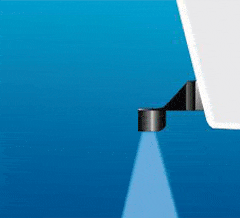
 Taking the time to research and plan how and where you are going to mount the transducer on your new depth sounder or fish finder will pay dividends out on the water. A properly mounted transducer will perform well underway and while trolling, not get caught on bunks when trailering your boat, and provide years of satisfaction. This article is based on a single engine vessel, so if you have multiple outboards or inboard-outboards please watch the video at the end of this article after reading the 4 Key Steps to Transom Mounting a Transducer on a Boat.
Taking the time to research and plan how and where you are going to mount the transducer on your new depth sounder or fish finder will pay dividends out on the water. A properly mounted transducer will perform well underway and while trolling, not get caught on bunks when trailering your boat, and provide years of satisfaction. This article is based on a single engine vessel, so if you have multiple outboards or inboard-outboards please watch the video at the end of this article after reading the 4 Key Steps to Transom Mounting a Transducer on a Boat.
1. OBSERVE TRANSOM TURBULENCE
When I transom mount a transducer the first thing I want to do is get an understanding of what is happening behind the boat while it is underway. Please be very careful when doing this and make sure you have on your PFD and have a trusted captain at the helm of your boat. I like to stand towards the transom of the boat while it is underway and look over the transom at the water flowing from beneath the boat, particularly on the starboard side. I make a mental note of where I see clear, turbulence free water. These conditions will allow the transducer to maintain accurate echoes while underway and, in turn, give great performance from your depth sounder or fish finder. Once I have a good idea of where I am getting good “clean” water I can get the boat up on the trailer or lift and start my installation.
2. LOOK FOR OBSTACLES THAT CREATE TURBULENCE
When I am ready to begin the install the transducer, the first things I look for are strakes and steps. You never want to mount the transducer directly behind any of these as they cause turbulence and can interfere with the performance of the depth sounder. Next, if the boat is trailered or loaded onto a lift I check and note where the bunks are and if they will interfere with my new transducer. Failing to take this step could result in damaging your transducer or bunk the next time you load the boat.
3. DETERMINE THE TRANSDUCER MOUNTING ANGLE
The general rule of thumb is to mount the transducer to the starboard side, which is the down stroke of most single outboard boat propellers (right hand lower unit). This side produces the least amount of turbulence and is most efficient in delivering the best performance. You want to find a spot as far away from the lower unit as you can while still allowing proper installation parameters and good contact with the water. Once you have found your spot, you need to assess the angle of your transom. The standard angle for transom is 13 degrees but they vary and most transom mount kits come with shims to account for variances. I like to see the transducer angled “bow high” at about 3 degrees. Meaning the leading edge of the transducer is tilted up slightly. The slightest bit of downward angle can cause the transducer to nose-down causing turbulence and poor performance. Once you have figured out the transom angle, and if shims are necessary, its time to move on to mounting the bracket.
4. MOUNT THE BRACKET AND TRANSDUCER
When mounting the bracket, I like to give myself room for adjustment. Particularly the ability to move the transducer lower into the water. You want to have the leading edge of the transducer no more than 1/8” below the transom as a starting point. I put the transducer in the bracket, mock it up with the transducer 1/8 th of an inch below the hull, and mark the holes towards the bottom of the bracket's adjustment openings. This way I have a little wiggle room to move it up and lots to move it down. The reason for this is if you experience poor readings, especially at speed, lowering the transducer into the water can often improve this condition.
After your holes are marked, mount the transducer, run the cable, and get out on the water! If you need to adjust the transducer, refer to this article or watch our video on transom mounting.
